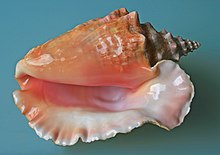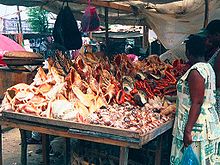| This article needs additional citations for verification. Please help improve this article by adding citations to reliable sources. Unsourced material may be challenged and removed. Find sources: "Conchology" – news · newspapers · books · scholar · JSTOR (July 2016) (Learn how and when to remove this message) |


Conchology (from Ancient Greek κόγχος (kónkhos) 'cockle' and -logy) is the study of mollusc shells. Conchology is one aspect of malacology, the study of molluscs; however, malacology is the study of molluscs as whole organisms, whereas conchology is confined to the study of their shells. It includes the study of land and freshwater mollusc shells as well as seashells and extends to the study of a gastropod's operculum.
Conchology is now sometimes seen as an archaic study, because relying on only one aspect of an organism's morphology can be misleading. However, a shell often gives at least some insight into molluscan taxonomy, and historically the shell was often the only part of exotic species that was available for study. Even in current museum collections it is common for the dry material (shells) to greatly exceed the amount of material that is preserved whole in alcohol.
Conchologists mainly deal with four molluscan orders: the gastropods (snails), bivalves (clams), Polyplacophora (chitons) and Scaphopoda (tusk shells). Cephalopods only have small internal shells, with the exception of the Nautiloidea. Some groups, such as the sea slug nudibranchs, have lost their shells altogether, while in others it has been replaced by a protein support structure.
Versus shell collecting

The terms shell collector and conchologist can be regarded as two distinct categories. Not all shell collectors are conchologists; some are primarily concerned with the aesthetic value of shells instead of their scientific study. It is also true that not all conchologists are shell collectors; this type of research only requires access to private or institutional shell collections. There is some debate in the conchological community, with some people regarding all shell collectors (regardless of motivation) as conchologists.
History
Shell collecting, the precursor of conchology, dates back thousands of years. Archaeologists have sometimes uncovered Stone Age oceanic seashell necklaces in areas far from the ocean, indicating that they were traded, and shell jewellery has been found at archaeological sites around the world.

During the Renaissance people began collecting natural objects of beauty for private cabinets of curiosities. Because of their attractiveness, variety, durability and ubiquity, shells frequently became a large part of such collections. Scientific interest began to develop towards the end of the 17th century, and in 1681 The Jesuit priest Filippo Bonanni published the two-volume atlas Ricreazione dell'occhio et della mente nell'osservazione delle chiocciole ("Recreation of the eye and of the mind in the observation of molluscs"), the first treatise devoted entirely to mollusc shells. In 1692 Martin Lister published Historia Conchyliorum, a comprehensive conchological text with more than 1,000 engraved plates.

George Rumpf, or "Rumphius", (1627–1702) published the first genuine mollusc taxonomy. He suggested the categories "single shelled ones" (modern Polyplacophora, limpets, and abalone), "snails or whelks" (Gastropoda), and "two-shelled ones" (Bivalvia). He did not include the tusk shells or the internal shells of the cephalopods.
Many of Rumpf's terms were later adopted by Carl Linnaeus. The study of zoology, including conchology, was revolutionized by Linnaeus and his system of binomial nomenclature. Six hundred eighty three of the approximately 4,000 animal species Linnaeus described are now considered to be molluscs, although Linnaeus placed them in several different phyla at the time. The English word "conchology" was coined in the 1770s by the British Sephardi naturalist Emanuel Mendes da Costa, who published The Elements of Conchology: or, an Introduction to the Knowledge of Shells in London in 1776.
Since 1700 a number of prominent conchologists have published their studies of shells. John Mawe (1764–1829) produced arguably the first conchology guidebook, The Voyager's Companion or Shell-Collector's Pilot, as well as The Linnæan System of Conchology. Hugh Cuming (1791–1865) is famous for his huge collection and numerous discoveries of new species. Thomas Say wrote the fundamental work American Conchology, or Descriptions of the Shells of North America, Illustrated From Coloured Figures From Original Drawings, Executed from Nature in six volumes (1830–1834).
R. Tucker Abbott was arguably the most prominent conchologist of the 20th century, authoring dozens of books and working as museum director of the Bailey-Matthews Shell Museum. His most best-known works are American Seashells, Seashells of the World, and The Kingdom of the Seashell. John DuPont is also known for his extensive collection which he donated to the Delaware Museum of Natural History in 1984. The Japanese emperor Hirohito also amassed a huge collection, and was a competent and respected amateur conchologist.
In 1950, Joyce Allan, an Australian conchologist working as curator of shells at the Australian Museum, authored Australian Shells. This was the first book to catalogue the majority of Australian molluscs in detail and was highly regarded within the scientific community and mollusc collectors.
Museums
Many museums worldwide contain very large and scientifically important shell collections. However, in most cases these are research collections not as readily accessible to the general public as exhibits.
As of 2020 the world's largest assemblage of mollusc shells was held by the Smithsonian Institution, which has c. 1 million lots representing perhaps 50,000 species. The Burke Museum of Natural History and Culture also has a large collection which was donated by Dr. Phil Nudelman in 2013. It includes about 100,000 specimens and 24,000 species, mostly from the Indo-Pacific region, the Caribbean, and the Mediterranean.
United States
- Academy of Natural Sciences, Philadelphia
- American Museum of Natural History, New York City
- Bailey-Matthews Shell Museum in Sanibel Island, Florida: the only museum in the world dedicated entirely to shells.
- Charleston Marine Life Center, Oregon Institute of Marine Biology in Charleston Oregon
- Denver Museum of Nature & Science, Denver, Colorado: approximately 17,500 shell lots.
- Museum of Comparative Zoology at Cambridge, Massachusetts
- National Museum of Natural History, Washington D.C. – The Smithsonian has c. 1 million lots, the largest worldwide
Europe
- Austria, Vienna – Naturhistorisches Museum
- Belgium, Brussels – Royal Belgian Institute of Natural Sciences, one of the three largest collections
- France, Paris – Muséum national d'Histoire naturelle 900,000 lots, 5 million specimens
- Germany
- Frankfurt – Naturmuseum Senckenberg, 700,000 lots (33,000 living taxa, 12,000 fossil taxa)
- Berlin – Berlin's Natural History Museum
- Netherlands, Leiden – Natural History Museum, Leiden
- Sweden, Stockholm – Swedish Museum of Natural History
United Kingdom
Source:
- London – Natural History Museum 8 million specimens, 60,000 type specimens
- Cardiff – National Museum Cardiff, second largest UK collection, over 2 million specimens
- Manchester – Manchester Museum, fourth largest UK collection; 166,000 lots.
- Cambridge – Cambridge University Museum of Zoology, over 100,000 lots
Organizations
Like other scientific fields, conchologists have a number of local, national, and international organizations. There are also many organizations specializing in specific subareas.
- Association Française de Conchyliologie
- Belgian Society for Conchology
- Club Conchylia, the German/Austrian Society for Shell Collecting
- Conchological Society of Great Britain and Ireland
- Conchologists of America
- Conquiliologistas do Brasil
- Nederlandse Malacologische Vereniging
- Unitas Malacologica
Depictions of shells on stamps and coins
Shells have been featured on over 5,000 postage stamps worldwide, and have been featured on many coins including the Bahamian dollar (1974), the Cuban peso (1981), the Haitian gourde (1973), the Nepalese rupee (1989) and Philippine peso (1993).
See also
References
- Karin Leonhard (2007). "Shell Collecting. On 17th-Century Conchology, Curiosity Cabinets And Still Life Painting". Early Modern Zoology: The Construction of Animals in Science, Literature and the Visual Arts. Brill: 192–196. doi:10.1163/ej.9789004131880.i-657.52. ISBN 9789047422365.
- "Jacksonville Shells – WWW.JAXSHELLS.ORG". jaxshells.org. Archived from the original on 2017-08-02. Retrieved 2008-09-28.
- "Oxford English Dictionary, s.v. conchology".
- J. Cosmo Melville (Jan 1890). "British Pioneers in Recent Conchological Science. 1662–1858". Journal of Conchology. 6: 190–223.
- "Joyce Allan, Conchologist". The Australian Museum. Archived from the original on 2016-12-22. Retrieved 2022-10-25.
- ^ Sierwald, P.; Bieler, R.; Shea, E.K.; Rosenberg, G. (1 December 2018). "Mobilizing Mollusks: Status Update on Mollusk Collections in the U.S.A. and Canada". American Malacological Bulletin. 36 (2): 177. doi:10.4003/006.036.0202.
- "A one-of-a-kind shell collection". Burke Museum. Archived from the original on 2020-10-18. Retrieved 2020-11-03.
- "Research Collection". mcz.harvard.edu. Retrieved 2024-02-21.
- "Marine, terrestrial, and freshwater molluscs". Muséum national d'Histoire naturelle. Archived from the original on 18 September 2020. Retrieved 15 September 2020.
- "Malacology Collection". Senckenberg. Archived from the original on 8 September 2020. Retrieved 15 September 2020.
- ^ "The collections". Mollusca types in Great Britain. Archived from the original on 27 November 2021. Retrieved 15 September 2020.
- "Mollusca". National Museum Wales. Archived from the original on 14 August 2020. Retrieved 15 September 2020.
- McGhie, Henry A. (17 December 2008). "Catalogue of type specimens of molluscs in the collection of The Manchester Museum, The University of Manchester, UK". ZooKeys (4): 1–46. Bibcode:2008ZooK....4....1M. doi:10.3897/zookeys.4.32. Archived from the original on 27 July 2009.
- "Molluscs". University of Cambridge. 24 March 2018. Archived from the original on 23 October 2020. Retrieved 15 September 2020.
- "BVC". bvc-gloriamaris.be. Archived from the original on 2009-05-18. Retrieved 2006-02-06.
- "German Shell Collector's Club". club-conchylia.de. Archived from the original on 2017-08-10. Retrieved 2006-12-12.
- "Home page – The Conchological Society of Great Britain and Ireland". conchsoc.org. Archived from the original on 2018-08-09. Retrieved 2006-12-12.
- "conchologistsofamerica.org". Archived from the original on 2017-08-12. Retrieved 2006-12-12.
- "spirula.nl". Archived from the original on 2020-09-19. Retrieved 2012-08-15.
Sources
- National Geographic Magazine, March 1969, "The Magic Lure of Sea Shells", Paul A. Zahl
- Seashells of the Northern Hemisphere, 1990, Surrey, R. Tucker Abbott
External links
Listen to this article (7 minutes)- The Bailey-Matthews Shell Museum in Sanibel Island
- A site for amateurs
- Beautiful Shells (1856) by H. G. Adams
Conchological organizations
- Association Française de Conchyliologie
- Conchologists of America
- Conchological Society of Great Britain and Ireland
- Club Conchylia, the German/Austrian Society for Shell Collecting
- Belgian Society for Conchology
- Conquiliologistas do Brasil